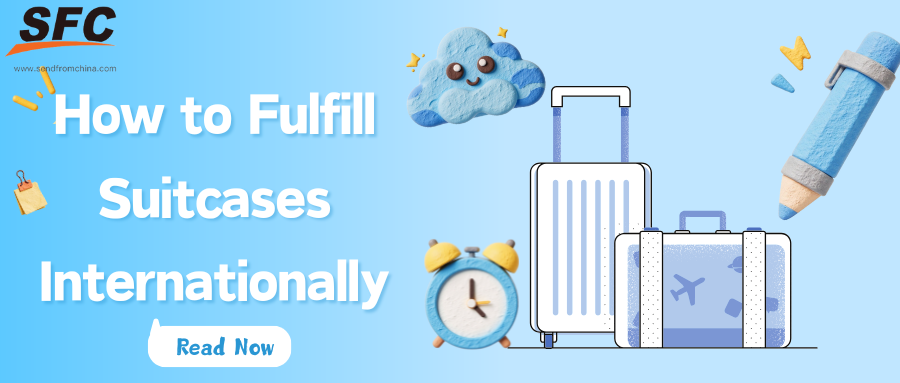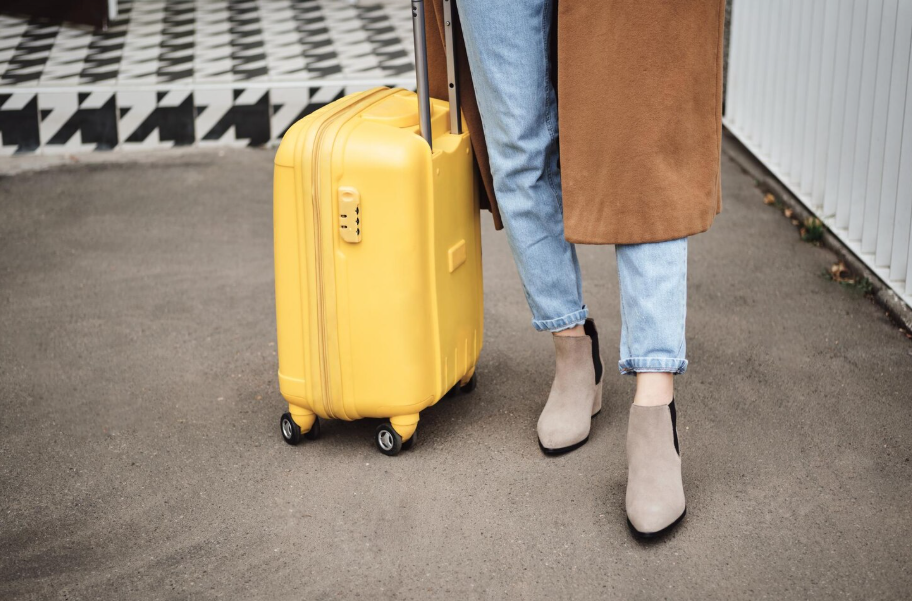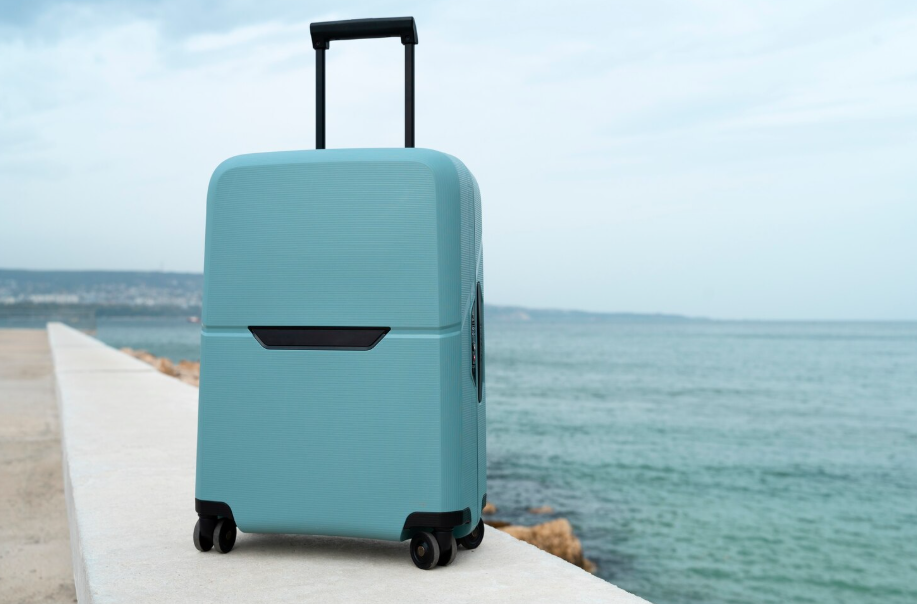Table of Contents
Get Custom eCommerce Fulfillment Service
Book a Meeting
How to Fulfill Suitcases Internationally
Time: Nov 26,2025 Author: SFC Source: www.sendfromchina.com
Moving suitcase across borders is no longer limited to airline check-ins. For frequent travelers, expatriates, students, or businesses shipping personal goods, using a third-party logistics (3PL) service to fulfill suitcases internationally has become a practical, efficient, and often cost-effective solution. As a China-based 3PL provider, SendFromChina helps clients navigate this complex landscape — from packing and shipping to customs, insurance, and final delivery.

In this guide, we explain how to fulfill suitcases internationally, covering:
Why ship suitcases instead of flying them
Choosing the right shipping solution
Proper packing and labeling
Customs, duties, and documentation
Insurance and risk management
Tracking, delivery, and final-mile considerations
Common challenges and how to mitigate them
Cost factors and budgeting
1. Why Ship Suitcases Instead of Flying Them
Before diving into logistics, it's helpful to understand why more businesses are choosing to ship their suitcases internationally. Here are several strong reasons:
Avoid excess baggage fees: Airlines often charge steep fees for overweight or extra bags. Using a baggage courier can be significantly cheaper than paying airline surcharges. ParcelHero, for example, notes that their suitcase courier service helps customers skip excess baggage costs.
Convenience: Shipping your suitcase door-to-door means you don’t have to haul heavy suitcases through airports, wait in check-in lines, or risk missing connecting flights.
Reliability and tracking: Unlike relying on airline baggage handling (where bags are sometimes lost, delayed, or mishandled), 3PL-based shipping gives you real-time tracking and more control over the process.
Scalability: Businesses, retail brands, or resellers may need to ship multiple pieces of suitcase, samples, or promotional goods. A 3PL can handle scale more efficiently than ad hoc airline shipping.
Given these benefits, suitcase shipping via a third-party logistics provider is increasingly attractive. But choosing the right solution and doing it properly requires careful planning.
2. Choosing the Right Shipping Solution
Not all shipping services are equal, especially when it comes to suitcase. Here are some of the main options and how to evaluate them.

Courier-based suitcase Shippers
These are specialty services focused on moving suitcases, bags, and personal effects. Examples include SFC, ShipGo, Airosuitcase, and others:
SFC: Delivers to over 200 destinations, offers door-to-door collection, and helps with customs forms.
ShipGo: Operates in 180 countries, offers 24/7 tracking, on-time delivery guarantee, and complimentary insurance.
Airosuitcase: Provides door-to-door collection and delivery; after booking, they send you labels to attach to your suitcase.
These services are ideal for travelers, expatriates, students, or individuals who want to avoid airline baggage hassles.
Traditional Couriers / Express Services
Major courier companies like UPS, FedEx, and DHL also support suitcase shipping. For instance, via Eurosender you can book a UPS service for suitcases.
Advantages:
Global reach: Large courier networks.
Speed: Express options if timing is critical.
Tradeoffs:
Cost: May be more expensive per kilogram than consolidated suitcase carriers.
Packaging: May require boxing and additional protective measures.
Freight Forwarders / 3PL-Based Solutions
For larger-scale, less time-sensitive shipments (e.g., relocation, equipment, or bulk personal effects), freight forwarding may be ideal. Here’s how 3PL providers, like SendFromChina, come into play:
Consolidation: Combine multiple suitcases or small boxes into one container or LCL (less-than-container-load) shipment to reduce costs.
Custom clearance expertise: 3PLs handle customs documentation, HS classification, duties, and import compliance.
Flexible delivery: Choose door-to-door, port-to-door, or other preferred terms (e.g., DAP, DDP).
Economy: Over long distances or large volumes, sea freight may be more cost-effective than air courier.
3. Proper Packing and Labelling before Shipping Suitcases
One of the most critical steps for shipping suitcases internationally is how you pack and label them. Improper packing can lead to damage, delays, or customs issues.

Packing Your Suitcase
Stabilize contents: Make sure items inside the suitcase are tightly packed so they don’t shift during transit. Eurosender, for example, recommends filling spaces, using internal padding, and ensuring the suitcase is stable.
Use an outer box or wrap: While some services will ship the suitcase as-is, it is often safer to place the suitcase into a sturdy cardboard box. Europacco advises wrapping the bag with nylon film or boxing it to protect against bumps.
Remove airline tags: Clear the suitcase of any old airline or travel tags; these can confuse couriers or customs. Eurosender suggests removing old tags before attaching shipping labels.
Seal and secure: Use heavy-duty packing tape to seal the box or secure the film wrap. Ensure that seams are reinforced.
Label placement: Attach shipping labels visibly on the outer packaging. Use a clear plastic pouch or document wallet to affix customs and airway bill documents. Europacco suggests placing the customs forms in a clear pouch and fixing them securely in view.
Fragile items: If there are fragile or valuable contents, add extra padding (bubble wrap, foam, or soft clothes) to absorb shocks.
Documentation and Labeling
Customs declaration: Clearly declare the contents of the suitcase (personal effects, clothing, documents, etc.). Some carriers or 3PLs will require a detailed packing list.
HS codes: For some items or when shipping via 3PL, you may need to list HS (Harmonized System) tariff codes.
Address accuracy: Ensure both pick-up and delivery addresses are correct, complete, and able to receive large shipments.
Consignee contact: Provide a phone number or email for the receiving party, especially for customs or delivery.
Incoterms: Clarify which incoterm you are using. Are you shipping Delivered At Place (DAP) or Delivered Duty Paid (DDP)? This affects who pays duties and handles customs clearance.
4. Customs, Duties, and Documentation
Cross-border suitcase shipments face customs scrutiny, and understanding duties and regulations is essential to smooth fulfillment.

Import Duties and Taxes
Import duty basics: Customs authorities typically calculate import duties based on the value of the items (often including the shipping cost and insurance).
Who pays: Depending on your shipping agreement, either you or the recipient may be responsible for duties. Under Delivered Duty Unpaid (DDU, now commonly DAP), the buyer/importer handles the tax. Under Delivered Duty Paid (DDP), the shipper pays everything.
Personal effects vs. commercial goods: Many countries treat used personal items (clothes, personal effects) differently than commercial shipments. It’s important to declare them accurately. Misdeclaring personal suitcase as commercial goods can lead to unexpected duties or delays.
Customs Documentation
Commercial invoice or packing list: Even for personal suitcase, many carriers will want a packing list showing what’s inside.
ATA Carnet: If your suitcase contains certain nonperishable professional or business items and you plan to bring them back, an ATA carnet can help you temporarily import them without paying duties.
Proof of personal use: If required, having documentation (e.g., inventory, photos) to prove that items are used personal effects can smooth customs clearance.
Import license (if needed): For certain countries or very high-value items, import licenses or special permits might apply.
Customs broker / 3PL support: A trusted 3PL like SendFromChina can manage the customs paperwork, classifying items correctly, calculating duties, and ensuring compliance — reducing the risk of delays or fines.
Special Regulations & Risks
Regulated items: Be aware of any restricted or prohibited items in the destination country (e.g., electronics, lithium batteries, liquids).
Misdeclaration risk: As some users have reported, calling items “personal effects” incorrectly can backfire. > “Writing ‘personal effects’ anywhere on a customs declaration is the easiest way to get parcels returned …”
Confiscation or fines: In rare but serious cases, customs authorities may confiscate or fine shipments that violate their import rules. For example, Chinese customs guidelines warn that personal effects improperly declared may be denied re-export.
5. Insurance and Risk Management
Shipping suitcase internationally involves risks — damage, loss, theft, or delays. Proper insurance and risk mitigation are essential.

Insurance Options
Carrier / courier insurance: Many baggage shipping services include basic coverage.
3PL / freight insurance: If going via freight forwarder or 3PL, you can typically purchase freight insurance for higher-value items. This is especially important for valuable or fragile goods.
Valuation: Be honest about the declared value of the contents. Under-insuring can lead to insufficient compensation, while over-insuring may raise premiums.
Mitigation Strategies
Secure packing: As mentioned, well-packed suitcases (with internal stabilization and good outer protection) reduce the risk of damage.
Use tracking: Always use a service that provides tracking. Knowing where your suitcase is at each stage helps mitigate risk.
Work with trusted partners: A reputable 3PL, like SendFromChina, adds a layer of reliability via its shipping network and experience.
6. Tracking, Delivery, and Final-Mile Considerations
Once your suitcase is in transit, what happens next? Here are some key steps to make sure everything goes smoothly from pick-up to delivery.

Tracking and Visibility
Choose a service that offers real-time tracking so you can monitor the movement of your suitcase.
Ensure your 3PL provides updates at handover, customs clearance, and final delivery stages.
Confirm the estimated delivery time and make sure the receiving address is prepared to accept the package.
Final-Mile Delivery
Door-to-door vs. pickup point: Decide whether you want the suitcase delivered to a hotel, residence, or business.
Receiving arrangements: Ensure that someone will be present to sign or accept the delivery. If the recipient is staying at a hotel, confirm that reception can accept packages. ParcelHero explicitly recommends verifying that accommodation can receive shipments.
Customs clearance at destination: The 3PL may handle customs clearance, or the recipient may need to. Clarify roles well in advance.
7. Common Challenges & How to Mitigate Them
Even with a smooth plan, cross-border suitcase shipping can run into complications. Here are some common challenges and strategies to overcome them.

Delays in Transit or Customs
Mitigation: Build buffer time into your schedule. Allow for potential delays in customs, especially during peak seasons.
Proactive documentation: Submit accurate and detailed paperwork to minimize rejection or holds.
Damaged suitcase
Mitigation: Proper packing — internal padding, stabilizing contents, outer protection — is critical.
Insurance: Purchase adequate insurance based on the suitcase’s value and contents.
Unexpected Duties or Fees
Mitigation: Clarify your shipping terms (DAP vs. DDP) and who will pay duties.
Use a 3PL: A logistics provider like SendFromChina can estimate likely duties, classify items correctly, and help minimize surprises.
Non-Compliance with Regulations
Mitigation: Research import regulations for your destination country. Avoid declaring restricted items unless permitted.
Use expertise: Rely on a freight forwarder or 3PL with experience in customs compliance and cross-border delivery.
Loss of Items or Misrouting
Mitigation: Use tracking, and choose a provider with a reliable network.
Insurance: As above, ensure your coverage is sufficient.
8. Cost Factors & Budgeting
Here’s a breakdown of the primary cost drivers when fulfilling suitcases internationally:
Weight and volume: Heavier/larger items cost more, especially with air shipping.
Distance and route: Overseas routes, remote destinations, and less common lanes may cost more.
Shipping method: Express courier > standard courier > freight (air) > freight (sea).
Customs duties and taxes: Import duties, VAT/GST, and handling fees vary by country.
Insurance: Higher declared value and more comprehensive insurance increase cost.
Packaging: Cost of boxing, wrapping materials, tape, and labor.
Final-mile delivery: Door delivery is more expensive than pick-up point or freight-terminal delivery.
3PL service fees: This may include documentation, consolidation, customs brokerage, and handling.
When working with a 3PL, it's critical to request a detailed quote that breaks down all of these factors, so there are no hidden fees. A transparent 3PL should provide cost scenarios for different shipping modes (air, sea, express) and help you make the best choice for your budget and timeline.
9. Best Practices for Working with a 3PL (Like SendFromChina)
To get the most value and avoid pitfalls when using a 3PL to fulfill suitcases internationally, follow these best practices:
Communicate clearly: Provide your 3PL with accurate dimensions, weight, contents, and value early on.
Define roles: Agree on who handles customs, duties, insurance, and paperwork.
Choose the right Incoterm: Decide between DAP, DDP, or other terms based on your tolerance for duties and risk.
Leverage consolidation: If shipping multiple suitcases or small packages, consolidate them to reduce cost per unit.
Use trusted networks: Work with a 3PL that has established global partnerships and experience in suitcase forwarding.
Track actively: Use the 3PL’s tracking portal, and set up notifications.
Prepare the receiver: Let the person at the destination know when the suitcase is arriving and what to expect — include import and delivery steps.
Plan for contingencies: Insure properly, budget buffer time, and have backup delivery options if someone is not available to receive.
10. Conclusion
Shipping suitcases internationally — whether for travel, relocation, or business — is no longer a luxury but an increasingly practical choice. By leveraging a professional 3PL like SendFromChina, you gain access to global networks, customs expertise, cost optimization, and reliable delivery. Success lies in careful planning: from packing and labeling, through customs documentation and payment of duties, to tracking and final delivery.
You save time, reduce stress, and often save money compared to airline baggage fees. But more importantly, you gain control — knowing exactly where your belongings are, how they travel, and when they’ll arrive.
11. FAQs
1. Can I ship a suitcase internationally instead of checking it on a plane?
Yes — many suitcase courier or 3PL services support door-to-door international shipping, which can be more convenient and cost-effective.2. Do I need to box my suitcase?
While not always required, boxing or wrapping your suitcase adds protection and reduces the risk of damage during transit.3. Who pays customs duties and taxes?
It depends on your shipping agreement (Incoterm). Under DAP, the recipient usually pays; under DDP, the shipper covers duties.4. How can I insure my suitcase?
Purchase insurance through your courier or 3PL. Declare the correct value, and choose coverage that matches your risk tolerance.5. How long does it take for a shipped suitcase to arrive?
It varies: express courier may take a few days; standard courier or air freight may be one to two weeks; sea freight could take several weeks depending on the route. Post Views:41
Post Views:41
Copyright statement: The copyright of this article belongs to the original author. Please indicate the source for reprinting.
Previous Post
Next Post
TAGS
Hot Research
Get Custom eCommerce Fulfillment Service
Book a Meeting
Get a Custom China Fulfillment Solution with FREE Storage for 30 Days
 Want to know about our services, fees or receive a custom quote?
Want to know about our services, fees or receive a custom quote?
 Please fill out the form on the right and we will get back to you within a business day.
Please fill out the form on the right and we will get back to you within a business day.
 The more information you provide, the better our initial response
will be.
The more information you provide, the better our initial response
will be.





 TAGS:
TAGS: